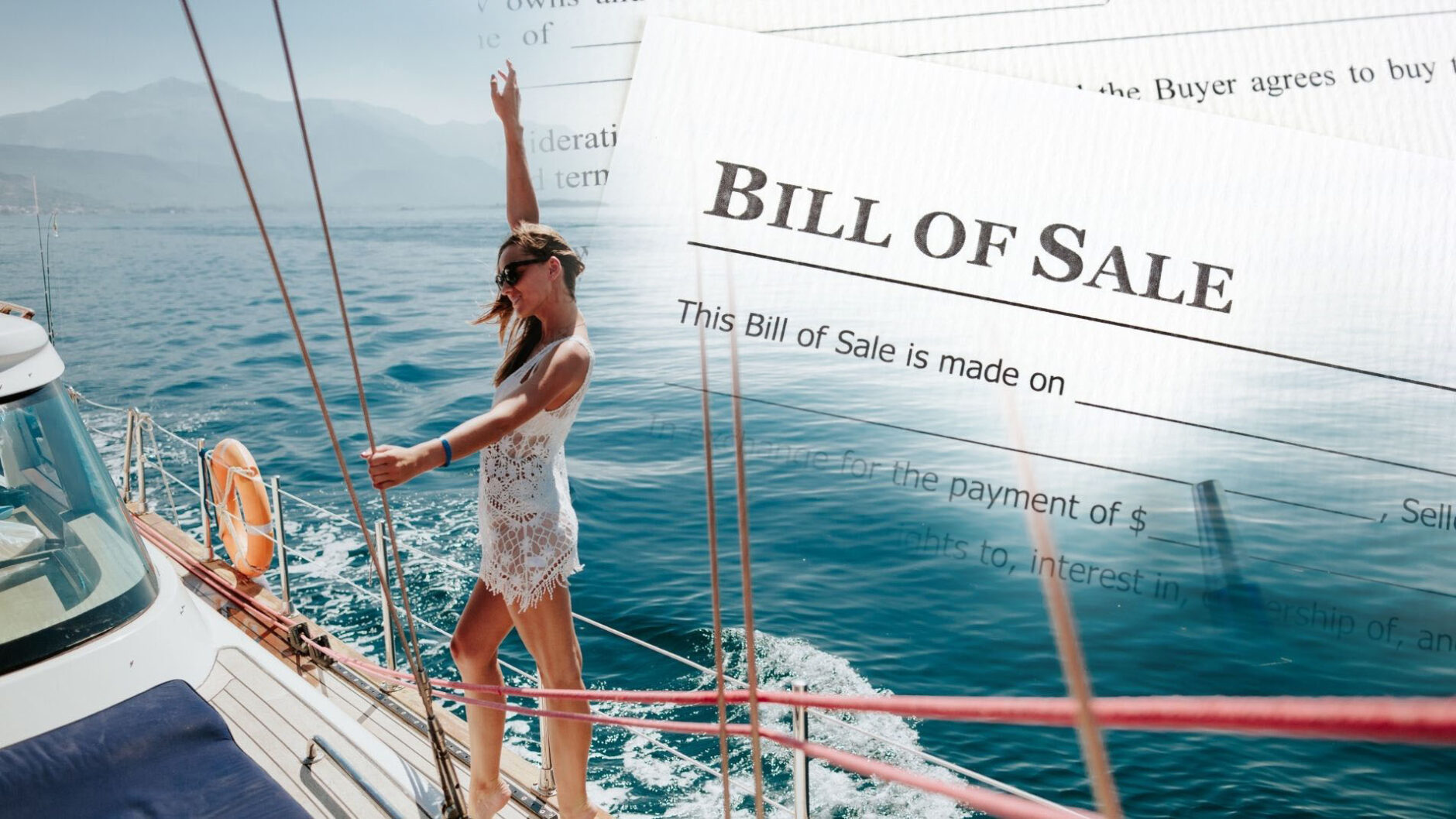After selling a boat, a seller gives a buyer a legal document called a boat bill of sale, which contains information about the boat sale. It signifies the change of ownership between the two parties involved: the buyer and the seller. The document is necessary in most US states when registering after buying a boat. The document symbolizes the end of a sale regardless of whether the buyer has paid for the vessel or not. So, as a seller, you have to be careful and only issue it after you have received all the payment for the boat for sale.
This document is important to both the buyer and seller for several reasons. It shields the buyer from fraud accusations since they can use it as proof of payment, and it also protects the seller in case something goes wrong after the boat sale, such as an accident. Each party keeps a copy of the bill of sale document.
You need this document when selling any boat, including a yacht, skiff, canoe, jet ski, tugboat, sailboat, kayak, rowboat, catamaran and motor/powerboat. The key details that you need to provide in the document are the seller's details (name that matches the name in the official ID documents, signature and email address), buyer's details, boat details (make, title number, year, Hull ID, odometer reading in hours), location and purchase price. It should also contain the payment method; in some states, it should be notarized to make it legally binding.

A Bill of Sale: The Process of Selling or Buying a Boat
1. Deciding What You are Selling Exactly
As a seller, when you finally decide to sell your precious vessel, you need to decide what other item you will sell alongside the boat. These items include life jackets, trailers, paddles and outboard motors. The tools you sell will impact the final sales price of the watercraft. However, it will also depend on whether the buyer wants them.
2. Preselling Preparations
Before selling your boat, there are crucial preparations you need to make to increase the chances of finding a buyer fast and getting great returns from the sale. First, you should ensure you have the registration for every boat component and the title handy. Your state might need these details for sale, and they also assure the buyer that you are the actual owner of the vessel you are selling, and you are not using it as collateral for a loan. If there is no title, ensure you have a purchase agreement or the last bill of sale to show you own it. You may also need to show the buyer maintenance receipts to prove the watercraft is in good condition, so have those ready and readily available. Another critical thing to do on your boat is to clean it as thoroughly as possible. Wash all the nooks and crannies of your boat, both the interior and exterior.
Additionally, remove your personal belongings and decorations and repair any damages. Check whether the boat’s engine is functioning correctly and fix it if it has any problems. Disinfect, polish, and wax the boat to prepare it for viewing. Replace the canvas with a new one if the current one is torn or faded. If possible, do some upgrades, such as installing lighting and a marine GPS. At this stage, taking high-quality photos from all angles will also be wise to help the buyers see your vessel well when you list it online. All these will help you create an excellent first impression on the buyer, and they are more likely to buy it at a favorable price.
3. Value of the Boat
This is perhaps the most challenging stage of selling a boat. Determining the actual value of a boat will require you to do some research and settle on a figure, which can take time. Use a reliable listing like jdpower.com to know the average sales price of similar vessels. Check what a boat with the same model, year and make is going for in the local market. Doing this is essential because you don’t want to set a price that is too high or too low. If it is too low, you will incur losses; if it’s too high, it will be challenging to find a buyer.
4. Find an Experienced Broker
If your boat is selling for a price that exceeds $40,000, it is prudent to find a skilled broker to help you sell it. Besides listing it, they will also ensure the vessel is thoroughly cleaned and looks great. If the price of the boat is less than this amount, you will need to sell it yourself since brokers refuse to list such vessels. Some of the best sites where you can find buyers are Craigslist.org, eBay.com, Yatchworld.com, Boats.com and BoatTrader.com.
Remember, as explained earlier, you must ensure the boat is in its best shape before listing it for sale. Fix any issues it might have, paint, clean, polish and wax it. Besides providing some high-quality pictures of your vessel, also write a clear description of its features and state and the other accessories you will be selling alongside the boat. Your post must contain crucial details like the terms of sale, condition, size, upgrades, repairs, make, model and year.
5. Boat Viewing
One important thing to note as a seller is that the location of your boat is essential. Make sure it’s in a place where it will be easy to show to potential clients, such as in a boat club, stand, trailer on land or dock. If you don’t consider this factor and leave it in a crowded area such as on mooring, it will be hard for the buyer to check the inside of the vessel. This will make selling the boat difficult because people can only buy something this huge after they are satisfied with its condition.
6. Finishing the Negotiations
In all American states, it is a requirement by law that a seller and buyer should sign a boat bill of sale form. The form can also contain information about the trailed and outboard motor sales.
7. Closing
At the end of the transaction, the buyer should provide the payment, and the seller will give the title transferred to the buyer and any other registration documents. The two parties will also agree on who will pay the sales tax. Usually, the parties share the tax equally.
8. Boat Registration
The buyer is supposed to register the boat quickly after closing the sale. Registering involves presenting the bill of sale, title forms and other necessary documents. You may be required to pay a sales tax based on the state in which you are located. If you are sharing the tax with the seller, you are still the one who will need to handle the transaction.
How to Write the Bill of Sale
The Bill of Sale form has several sections to fill in and provide crucial information about the sale. These sections are:
1. Location of Sale
Here, you must write the bill of sale effective date and the country and state you are selling from. The date required here is the same as when the sales participants signed the last signatures.
2. The Parties
Here, you need to provide the names of the buyer and the seller. They must be the names that they use on their government-issued identifications. You also need to provide the email addresses the seller and the buyers have used when dealing with this sale.
3. The Exchange
In this section, you need to write the payment terms the seller wants the buyer to use to complete the transactions, such as cash payment, a check, a wire transfer, or a certified check. The exchange can also be in the form of a gift or a trade-in. If it is a trade-in, the buyer will input information about the boat they are submitting, and if it’s a gift, there is space on the form where the seller will write the value of the boat they are giving out as a gift.
4. The Boat
This is where you will provide details about the boat, including the boat model, year, title number and information, odometer, Hull ID number, trailer make, year and basic information, trailer License Plate number and VIN number, as well as motor make, year, HP and serial number.
5. Purchase Price
Here, the information required is the boat, motor and trailer costs and the total cost.
6. Sales Taxes
Here, the seller will check the correct box according to the terms of his sale. The two options are Included in the purchase price and NOT included in the purchase price.
7. Authorization
This section requires you, the seller and the buyer to write print names, provide signatures and the date of the day you are filling out the form.
8. Notary Acknowledgment
This is the part where the buyer and seller signatures are notarized. The notary public witnessing the buyer and seller signing will sign the document.
Wrapping Up
A bill of sale is a document showing the boat ownership has been transferred between two parties. Signing this document is vital because it helps prevent disputes and shows who owns the boat at a given time. However, it should be taken seriously, and the seller must avoid signing it before they have been paid.




